What is lipodystrophy?
Lipodystrophy is a broad term for disorders that are marked by partial or total loss of fat in the body. The condition is both acquired as well as hereditary. Some physicians refer to the loss of adipose tissue as lipoatrophy instead of lipodystrophy.
Acquired lipodystrophy can be idiopathic or caused by AIDS and certain medicines, among various other causes. Acquired lipodystrophy is further classified as:
- Lawrence syndrome: Generalised loss of adipose tissue.
- Barraquer-Simons syndrome: Partial loss of adipose tissue.
- Localised lipodystrophy: Fat loss from specific body parts.
- Antiretroviral (ARV) therapy-induced lipodystrophy: Fat loss as a side effect of medicines for HIV infection.
The above syndromes are triggered by metabolic and hormonal imbalance. Thus, the condition may cause issues like:
- Ectopic lipid accumulation.
- Insulin resistance.
- Diabetes.
- Polycystic ovary syndrome (PCOS).
- Non-alcoholic fatty liver disease.
- Hypertriglyceridaemia (high triglyceride fat levels in the blood).
What are its main signs and symptoms?
The condition is quite rare, yet may prove fatal in the long run. The major symptoms include:
- Increase in waist size.
- Moon-shaped face, with fat accumulation in the cheeks and neck.
- Accumulation of fat in the breasts.
- Fat deposits in the upper back that gives the appearance of a hump.
- Pancreatitis or inflammation or swelling of the pancreas.
- Enlarged liver.
- Diabetes.
For females, the condition may present with the following symptoms along with those mentioned above:
- Hirsutism (male pattern of hair growth), with hair on the chin and upper lip (due to PCOS).
- Enlarged clitoris.
- Dark velvety skin around the nipples, of the underarms and hands.
In children, the condition is known to exhibit easy-to-identify symptoms like:
- Muscular appearance.
- Insulin resistance.
- High basal metabolic rate.
- Prominent belly button.
- The appearance of prominent veins.
- In some cases, arrhythmia.
What are its main causes?
As stated above, the condition is caused by two prominent factors, i.e. inherited and acquired.
- The congenital or inherited factor (congenital generalised lipodystrophy [CGL], familial partial lipodystrophy [FPL]). The condition may pass on from parents to children due to recessive gene traits or mutation in gene characters. In the case of FPL, the chances of inheritance increase to 50 per cent when a mutation occurs in the genes from one parent.
- The acquired factor (acquired generalised lipodystrophy [AGL], acquired partial lipodystrophy [APL])
Under AGL, the symptoms appear in response to the occurrence of:
- Type 1: Panniculitis (inflammation of subcutaneous fat)
The person suffers from painful and inflamed lesions on the skin. The scars remain after the healing process, with the overlying skin appearing absolutely normal. The subcutaneous fat loss is clearly visible in this case. - Type 2: Autoimmune disease
The occurrence of autoimmune disorders may trigger lipodystrophy. such people are known to have a history of AIDS or HIV-related issues. - Type 3: Idiopathic
In this type, autoimmune disorders and panniculitis are not seen and the underlying triggers remain unknown.
How is it diagnosed and treated?
The diagnosis of the condition can be established by identifying the characteristic symptoms. For example, people with AGL and APL suffer from loss of subcutaneous fat in the hands, genital area, feet and orbital region. The condition is also characterised by the occurrence of diabetes due to insulin resistance. Overall, the condition impacts the physical appearance and, as a result, even leads to psychological issues like depression.
For CGL and FPL, the symptoms start appearing at a young age. The muscular appearance along with abnormal fat loss are the signs to watch out for.
The treatment includes cosmetic approaches to rectify the physical effects:
- Injections.
- Implants.
- Cosmetic surgery.
- Liposuction.
Medical treatment includes:
- Treatment with human growth hormone (HGH).
- Lipid-lowering medications like statins and fibrates.
- Metformin for diabetics.
- Switch in ARV therapy.
Apart from the above, lifestyle changes can also be used as a short-term management option.
















